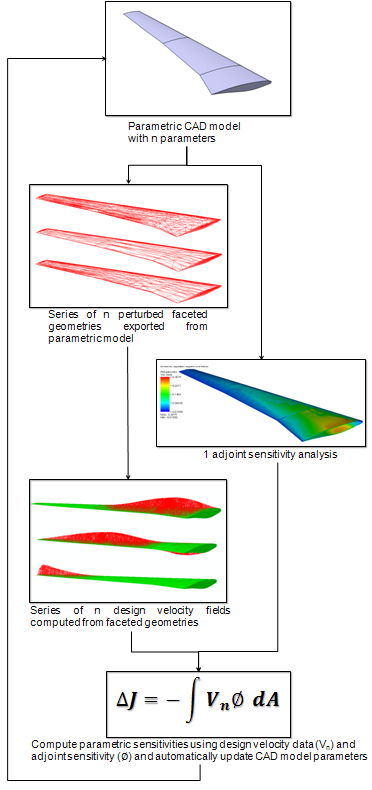Linking parametric CAD sensitivities with adjoint CFD data
Summary:
The aim of this research is to develop a tool to compute geometric CAD sensitivities called design velocities and link these with adjoint CFD simulation data to allow efficient aerodynamic optimisation of parametric CAD models.
Introduction:
Design velocity is a measure of geometric shape change in response to parameter change. It links parametric perturbation to boundary movement. More specifically, the normal component of design velocity (Vn) is the outward normal movement of a point on the model boundary due to a parametric perturbation.
Adjoint sensitivity maps can show the sensitivity of an objective function to boundary movement across a complete model boundary. The sensitivity map is computed from a single adjoint analysis, irrespective of the number of design parameters.
Linking these two concepts gives information on the relationship between CAD model parameters and model performance which can be used to optimise the model.
Method:
The diagram below illustrates the method used in this research. The process begins with a parametric CAD model with a certain number of parameters. The wing model shown is defined by more than 1000 parameters.

The method used to compute design velocities is based on a finite-difference approach using faceted approximations of the parametric CAD geometry.
Each appropriate CAD model parameter is automatically perturbed, and a faceted version of each perturbed geometry is exported. Each of these perturbed faceted geometries is then compared in turn to the original unperturbed geometry and a design velocity field computed for each parameter. The use of faceted models allows this data to be computed very efficiently, with each design velocity evaluation taking just a few seconds computation.
This design velocity field data is then combined with surface sensitivity data obtained from an adjoint CFD solver, allowing a sensitivity to be calculated for each model parameter. These sensitivities can then be used for gradient-based optimisation.
For complex aerodynamic models with many parameters, this method has the potential to significantly reduce the number of CFD computations required for optimisation compared to conventional finite-difference based methods of gradient evaluation.
Conclusion:
A method has been developed to enable automated computation of design velocity fields for parametric CAD models and link the resulting data with adjoint sensitivity results to allow efficient computation of parametric sensitivities for CAD models.